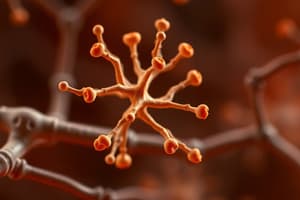Podcast
Questions and Answers
What are the functions of histidine?
What are the functions of histidine?
- Formation of carnosine and anserine
- Decarboxylation to histamine
- Production of glutamic acid pathway
- All of the above (correct)
What is the major pathway of histidine?
What is the major pathway of histidine?
Glutamic acid pathway
Histidine is a non-essential amino acid.
Histidine is a non-essential amino acid.
False (B)
Match the amino acid with its property:
Match the amino acid with its property:
Proline is formed from glutamic acid through the formation of glutamic semialdehyde and ______ carboxylic acid.
Proline is formed from glutamic acid through the formation of glutamic semialdehyde and ______ carboxylic acid.
Flashcards are hidden until you start studying
Study Notes
Amino Acid Metabolism
Histidine
- Essential, glucogenic amino acid
- Functions:
- Can be decarboxylated to form histamine, a vasodilator and a key substance in allergic diseases
- Combines with β-alanine to form carnosine and anserine, which have antioxidant properties and are present in vertebrate muscles
- Can give glutamic acid through the formation of urocanic acid and formimino glutamic acid as intermediate compounds
- Present in blood as ergothionine, a reducing substance found in RBCs
Proline
- Non-essential, glucogenic amino acid
- Functions:
- Can be hydroxylated to form hydroxyproline, a key component of collagen synthesis, with the help of vitamin C
- Formed from glutamic acid through the formation of glutamic semialdehyde and pyroline carboxylic acid
Glutamic Acid
- Non-essential, glucogenic amino acid
- Functions:
- Enters into the formation of γ-Aminobutyric acid (GABA), a key compound in the brain, through decarboxylation
- Synthesizes glutathione, a tripeptide formed with cysteine and glycine, which is a tissue respiratory enzyme
- Involved in the synthesis of folic acid (B10) and arginine
- Used in detoxication of ammonia, forming glutamine which is then converted back to glutamic acid and ammonia
Glutamine
- Non-essential amino acid
- Functions:
- Used to detoxicate phenyl acetic acid
- Involved in the synthesis of purines and pyrimidines, donating nitrogen atoms to the ring structures
- Used in detoxication of ammonia, forming ammonia and glutamic acid again
Aspartic Acid and Asparagine
- Non-essential, glucogenic amino acid
- Functions:
- Decarboxylated to form β-alanine, used in the synthesis of carnosine and anserine
- Involved in the synthesis of purines and pyrimidines, donating nitrogen atoms to the ring structures
- Can be converted to asparagine by adding ammonia, which can then be removed through deamidation
Arginine
- Semi-essential, glucogenic amino acid
- Functions:
- Involved in the synthesis of urea in the liver
- Used in the synthesis of creatine and creatine phosphate, along with glycine and methionine
- Can give glutamic acid and proline through the formation of glutamic semialdehyde
Lysine
- Essential amino acid
- Functions:
- Hydroxylated to form hydroxylysine in collagen synthesis
- Can give ammonia, but cannot be reanimated by ammonia
- Combines with biotin to form biocytin, a coenzyme for certain carboxylases
Studying That Suits You
Use AI to generate personalized quizzes and flashcards to suit your learning preferences.




